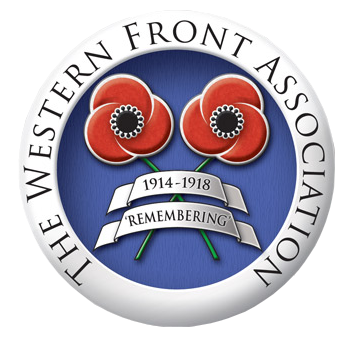Interesting and quirky examples of maps: a sample of just a handful
- Home
- World War I Articles
- TrenchMapper by The Western Front Association
- Interesting and quirky examples of maps: a sample of just a handful
Altogether some 7,000 maps have so far been published on TrenchMapper, and the sheer volume of these makes selecting interesting examples really difficult. Nevertheless, we have some 'highlights' for you here.
First of all, below we have an aircraft being photographed by another whilst flying over Tamil Farm near Moorslede in September 1918.

Above: Aerial photo p_005359
In the last 100 days of the war, machine guns were used in an indirect role, firing tightly-controlled barrages. This is the detailed Canadian machine gun map, near Cambrai.

Above: Map m_80_000369
On the edge of one of the many 'mosaic' images created from RFC/RAF aerial photographs we see how the modern wind turbine sits on the battlefield, but what are the white lines? Are they tracks created by supply wagons or by tanks?

Above: Aerial photo p_006174
After the attack on Fromelles in July 1916, Australian casualties were buried in mass graves. Ninety years later, exhumation from the burial pits shown in this 1918 photo took place and many were identified from DNA. This photo was one of those proving the location was correct for exhumation.

Above: Aerial photo p_005514
The British Army made extensive use of the caves and subways. TrenchMapper’s opacity slider reveals caves, tunnels and the modern Arras.

Above: Map m_018321
The unit war diary for the second battalion Tank Corps in June 1917 lets us see just where each one was on the date and sometimes at the actual hour.

Above: Tank Corps at Wytschaete. wo95_113_1_13
Staying with the theme of tanks here we can see six tanks near Messines, June 1917. Georeferenced on TrenchMapper.

Above: Aerial photo p_019921
Handwritten on an October 1917 map in the 36th Divisional area is the poignant note “I was wounded here” possibly with the initials EoG. The general area is the Hindenburg Support Line, NE of Villers-Plouich.

Above: map m_81_000100
The concept of overlaying RFC/RAF aerial photos onto Trench Maps was used during the war, as shown here, being an aerial montage of the Drocourt-Queant line glued by First World War cartographers onto a trench map. This is a Great War example of what our volunteers are doing only with the advantage of modern technology.

A note about how we overcome some of the difficulties of geo-referencing.
Some of the German maps cover the devastated areas of Verdun, Marne and Aisne etc. These are more of a challenge to geo-reference because the modern-day landscape is very different to that of over one hundred years ago. The normal method is to identify GCP's (Ground Control Points), eg. towns, villages, roads etc, on your Great War map and then match them to the same points on the present day map street map. In the areas of devastation there are few roads and villages left so GCP's have to be found by matching those tracks, woods and rivers which still exist by examining the satellite view of the area, as well as the street map. This can be a time-consuming exercise but once georeferenced though, that one map can be used as a "template" for other maps of the same area against which we can find the common GCP's. One way or another, every map gets the same expert attention to detail.
The process of incorporating trench maps into Trench Mapper has developed considerably since we started the project and our volunteers are continuing to georeference and upload around twenty new maps every day, some of which are extremely complex and require significant research to pin down into the modern landscape.
Sometimes we 're-discover' facts which may have been lost in the last hundred years, for example we have realised why we were struggling to georeference some of the 1915 maps of the Loos area. We eventually were able to fathom out some of the inaccuracies when our French volunteers informed us that the church (which we assumed was a 'fixed' position and had not 'moved') had in fact been re-located from where it was during the Great War. In addition, the position of Hill 70 is not where the new Canadian memorial is located, but is now in the vicinity of the prison on the northern outskirts of Lens. It can certainly be said that all of our volunteers' geographical knowledge of the Western Front have developed considerably!
There are hundreds more 'unusual examples', which we hope you enjoy finding using The Western Front Association's TrenchMapper. If you find some that you particularly like or think we should feature, please get in touch via mapping@westernfrontassociation.com





